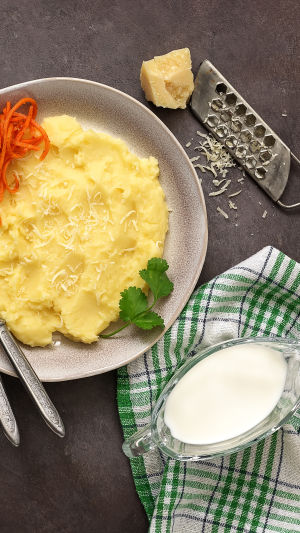When it comes to comfort food, few dishes can match the universal appeal of mashed potatoes. Whether served as a side dish, main dish, or the basis for other culinary creations, mashed potatoes have become a beloved classic in kitchens around the world.
This humble yet versatile dish has captured the hearts and tastebuds of generations, and its enduring popularity is a testament to its delicious simplicity.
A brief history:
The history of mashed potatoes has its roots in the Andes Mountains of South America, where indigenous communities have grown and consumed potatoes thousands of years ago. These early potatoes were distinct from the starchy, fluffy varieties we know today.
They are smaller, firmer, and often bitter. It wasn't until Spanish explorers brought the potato to Europe in the late 16th century that the potato began to undergo a transformation that would eventually lead to mashed potatoes.
The popularity of mashed potatoes in Europe is often credited to 18th-century French apothecary and nutritionist Antoine-Augustin Parmentier. After promoting the nutritional value of potatoes and overcoming initial resistance, Parmentier's efforts fostered the acceptance and adoption of potatoes as a staple food.
The Art of Sugaring
Mashed potatoes are a canvas for culinary creativity. The process of making mashed potatoes starts with choosing the right variety of potatoes. High-starch potatoes, such as russets, are often favored for their soft texture when cooked and mashed. Once the potatoes are peeled, diced, and cooked until tender, the mashing process begins.
Mashing can be done with a variety of tools: a potato masher for a rustic and slightly chunky texture, a fork for a smoother surface, and even a potato tamper for an incredibly soft consistency. The key to perfect mashed potatoes is striking the right balance between smoothness and texture.
Flavor palette
Mashed potatoes serve as a neutral base that can be customized to suit any taste. They can be made simple with just butter and cream for a rich and delightful taste, or they can be boosted with a variety of flavors and toppings.
Some popular supplements include:
Garlic: Roasting or sautéing garlic infuses potatoes with mild warmth and tangy flavor.
Herbs: Fresh herbs such as chives, parsley, thyme, or rosemary can add a burst of freshness and aroma.
Cheese: Cheddar, Parmesan, or Gruyere can be melted into the potatoes to create a creamy treat.
Sour Cream: For a tangy flavor, mix in sour cream, which provides a velvety texture and a hint of tartness.
While mashed potatoes are often considered a beloved side dish, they are also extremely versatile in culinary applications. They can be used as the base for shepherd's pie, a comforting casserole served with a layer of mashed potatoes.
Mashed potatoes can be formed into patties and fried to make crispy hash browns. They can even be used to add a creamy element to soups and stews.
Whether paired with a hearty roast, a delicious main course, or enjoyed on its own, mashed potatoes are more than just a dish, but a heartwarming experience that continues to captivate our taste buds and nourish our souls.





